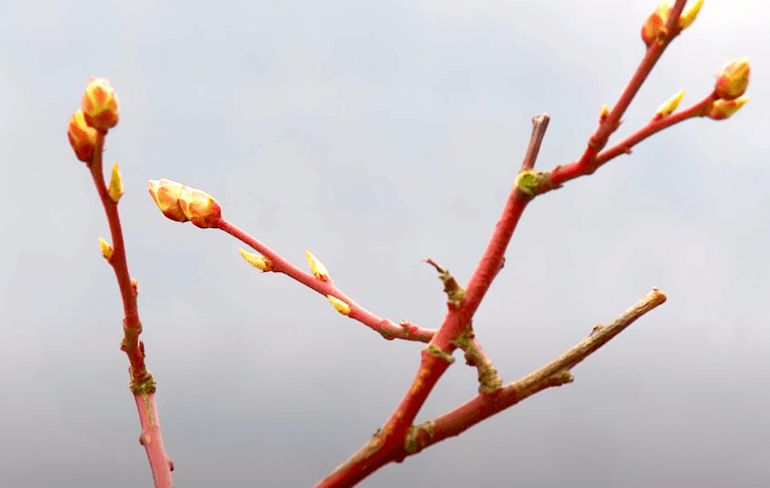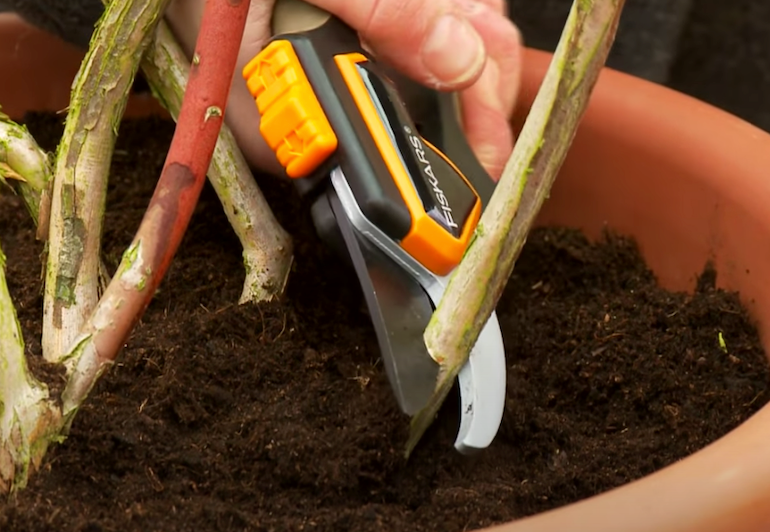
How to prune blueberries
Blueberry bushes should be pruned every year to rejuvenate the plant and encourage a good crop of large, plump fruits. Pruning is also essential if you're growing blueberries in a container and want to keep your plants at a manageable size. Here, horticultural expert Mandy Bradshaw shares her step-by-step guide to pruning a blueberry plant.
Browse our full range of blueberry plants for new varieties and traditional favourites.
When to prune a blueberry bush

Fruiting buds are rounder than leaf buds so you can easily spot the stems with more fruit
Image: Thompson & Morgan
Pruning is best carried out in February or early March when the plants are dormant. At that time of year, it’s easy to spot the fat buds that will produce fruit against the much smaller and thinner leaf buds. Take this into account when choosing what to cut and what to leave.
Blueberries grow on wood that's at least a year old, with harvests peaking on two-year-old stems before fading as the canes get older. Pruning should be used to slowly rejuvenate a plant by removing a proportion of the oldest branches every year. Stems that are more than four years old cease to bear much fruit, so pruning them out will encourage new growth. The more vigorous younger stems are easy to identify - they're a vibrant red colour as opposed to the grey "woodier" looking older stems. You’re aiming for a good balance of wood that’s between one and three years old. A mature bush should contain around one third young shoots, one third prime growth and a third older growth.
How to prune a blueberry bush

Cut back the oldest stems each year with clean secateurs
Image: Thompson & Morgan
- For the first two years, the aim of pruning is to create a bush with an open shape that allows air to circulate – think wine goblet.
- Remove branches that are crossing or rubbing against each other to prevent future disease.
- Blueberry bushes sometimes produce horizontal growth close to the ground and this should be pruned off, particularly if the branches are touching the earth.
- Take out any damaged or diseased stems and any that have died back due to cold weather. Remove all of them to a healthy bud. Spindly growth at the end of last year’s fruiting stems should also be taken back to stronger growth.
- On more mature plants, take out no more than a quarter of the oldest branches. These need cutting back to the ground to make way for new growth.
Pruning your blueberry bush every year keeps it in good shape and continually rejuvenates the plant by encouraging it to produce healthy new growth. Watch our short video on how to prune a blueberry bush for a quick recap.
Step-by-step video guide to pruning blueberry bushes
We hope this pruning guide has been helpful. Visit our hub page to learn more about blueberries including how to grow, best varieties and much more.
See all pruning guides
Individual guides
Flower & Shrubs
- Pruning Buddleja
- Pruning Camellias
- Pruning Clematis
- Pruning Fuchsias
- Pruning Hydrangeas
- Pruning Hypercium - St Johns Wort
- Pruning Lavender
- Pruning Magnolias
- Pruning Passion Flowers
- Pruning Rhododendron
- Pruning Ribes Sanguineum
- Pruning Rosemary
- Pruning Roses
- Pruning Tree Peonies
- Pruning Wisteria
- Pruning Asparagus
- Pruning Goji Berries
- Pruning Honeyberries
- Pruning Raspberries
- Pruning Apple trees
- Pruning Box and Yew trees
- Pruning Catalpa trees
- Pruning Christmas trees
- Pruning Olive trees
- Pruning Patio Fruit trees
- Pruning Pear trees
- Pruning Plum trees
Fruit & Veg
Trees

Written by: Mandy Bradshaw, the Chatty Gardener
Cotswold-based Garden Media Guild member, Mandy Bradshaw, is also known as the Chatty Gardener. Passionate about gardening and writing, her beginnings are in football reporting for her primary school, and Mesembryanthemum planting with her mother. Winner of the 2018 Property Press Awards 'Garden Journalist of the Year', she writes for not only her own blog but also a range of newspapers, magazines and other gardening and non-gardening sites.Banner image: Blueberry 'Duke' from Thompson & Morgan
Sign Up For Exclusive Special Offers




© 2025 Thompson & Morgan. All rights reserved. A division of Branded Garden Products Limited.



